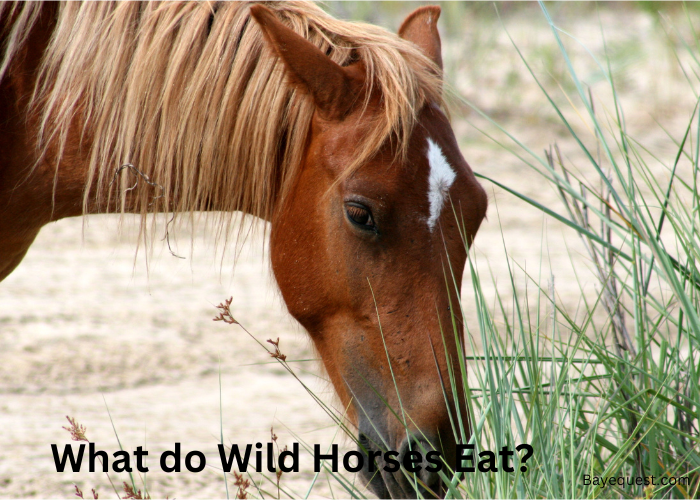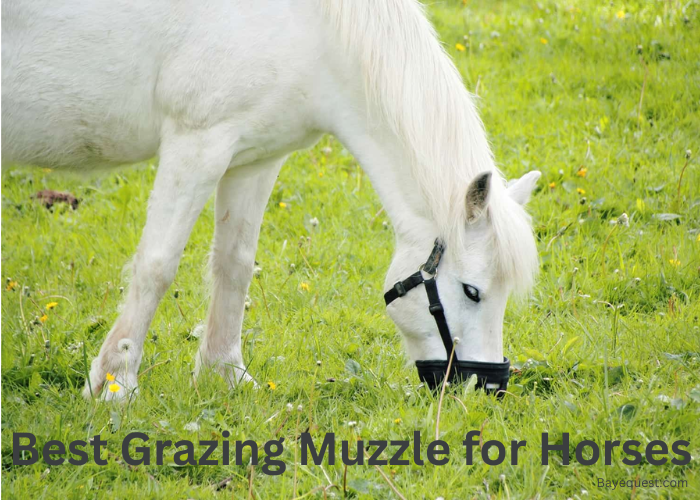Wild horses live in a world where they find their food on their own.
They roam vast landscapes, from open plains to rocky hills, finding just what they need to survive.
Unlike domesticated horses, they don’t rely on humans for hay or grains.
Instead, they munch on what nature provides and whatever else grows in their path.
But how do they know what to eat? And what keeps them strong through harsh winters and dry summers?
Let’s uncover the secrets behind a wild horse’s unique diet.
What Do Wild Horses Eat? Key Takeaway
Wild horses eat natural, available vegetation that varies with season and habitat. They rely on grasses, herbs, shrubs, and even hardy weeds to meet their nutritional needs. This diverse plant diet helps them survive in changing environments, ensuring they find sustenance year-round.
Nutritional Requirements of Horses
Like humans, horses need a balanced diet to stay healthy and perform at their best.
Understanding their nutritional requirements is essential for anyone involved in their care.
Let’s delve into the key nutritional elements vital for keeping horses in top condition.
Water
Water is the most critical nutrient for horses. It’s essential for digestion, temperature regulation, and waste elimination.
An average horse drinks 5 to 10 gallons of water daily, but this can vary depending on the horse’s size, activity level, and environmental conditions.
Carbohydrates
Carbohydrates are horses’ primary source of energy. They get carbohydrates mainly from forages like grasses and hay and grains such as oats, barley, and corn.
The amount of carbohydrates needed depends on the horse’s activity level. Carbohydrates also help maintain body condition and support healthy gut function.
Protein
Protein is vital for muscle development, repair, and overall growth. Horses obtain protein from forages, especially legumes like alfalfa, grains, and commercial feeds.
The protein requirement varies based on the horse’s age, workload, and reproductive status. Adequate protein is essential for maintaining muscle mass and overall health.
Fats
Fats are a concentrated energy source, particularly useful for providing sustained energy. They also help absorb fat-soluble vitamins and support coat and skin health.
Horses can consume fats from vegetable oils, rice bran, and flaxseed.
Vitamins and minerals
Horses need a balanced intake of vitamins and minerals to support bone development, muscle function, and immune health.
Key vitamins include A, D, E, and K, while essential minerals include calcium, phosphorus, magnesium, and potassium.
These nutrients are provided through a combination of forages, grains, and supplements.
What Do Horses Eat in the Wild?
Wild horses have a diverse diet that keeps them healthy and strong. They forage for various plants, adapting to their environment’s needs.
Let’s break down what wild horses typically eat.
Grasses
Grasses are the mainstay of a wild horse’s diet. They provide the bulk of the nutrition wild horses need.
Think of grasses as their bread and butter. These plants are packed with essential nutrients and fiber, which help with digestion and keep their energy levels up.
Wild forbs
Wild forbs are non-grass herbaceous plants. These are like the wildflowers and leafy greens of the wild.
Forbs add variety to the diet and offer different vitamins and minerals. They are a tasty and nutritious snack that wild horses love to munch on.
Bushes
Bushes are another part of the wild horse diet. These woody plants provide roughage and some nutrients.
When grasses and forbs are scarce, horses turn to bushes. They can chew on the leaves, twigs, and even bark to meet their needs.
Shrubs
Shrubs are similar to bushes but often smaller and denser. They are a reliable food source, especially in harsher conditions where other plants might not grow.
Shrubs offer a mix of leaves and small branches that help keep wild horses’ diets balanced.
Wild fruits
Wild fruits are a delightful treat for wild horses. These can include berries, apples, or any fruit they find growing in their habitat.
Fruits provide sugars and additional vitamins, giving horses a sweet energy boost.
Weeds
Weeds might not sound appealing, but they can be a valuable food source for wild horses. Weeds often grow in abundance and can be quite nutritious.
Horses aren’t picky and eat various weeds to satisfy their dietary needs.
How Do Horses Get Food in the Wild?
Wild horses have to fend for themselves when it comes to finding food. They don’t have anyone to feed them, so they rely on their instincts and the natural environment.
Let’s explore how these majestic animals find their meals in the wild.
Grazing
Grazing is the primary way wild horses get their food. They spend a significant portion of their day grazing on grasses.
This involves slowly moving across the landscape nibbling on the plants they come across. Horses have adapted to eat small amounts continuously, which helps them stay on the move and avoid predators.
Foraging
Foraging means searching for food beyond just grasses. Wild horses will seek out wild forbs, bushes, shrubs, wild fruits, and weeds.
They roam their habitat, using their keen sense of smell and sight to find these plants. Foraging helps them get a balanced diet with a variety of nutrients.
Seasonal movements
Wild horses often move with the seasons to find food. In the spring and summer, they may graze in lush meadows. In the fall and winter, they might move to lower elevations or more sheltered areas where vegetation is still accessible.
This seasonal migration ensures they have a steady food supply throughout the year.
Using water sources
Water sources are crucial for wild horses. Not only do they need to drink, but areas around water sources often have richer vegetation.
Wild horses often graze and forage near rivers, lakes, and streams where plants are more abundant and nutritious.
Adaptability
Wild horses are incredibly adaptable. They can survive in various environments, from grassy plains to desert regions.
This adaptability means they can eat various plants and switch their diet based on what’s available. If grasses are scarce, they’ll eat shrubs, bushes, and even hardy weeds.
Social behavior
Wild horses often live in groups, known as bands. These bands help each other find food.
An experienced lead mare guides the group to good grazing and foraging spots. This social structure ensures that all band members have a better chance of finding enough food.
What Do Wild Horses Eat in Winter?
In winter, wild horses survive by adapting their diet to the harsher conditions. They graze on dry grasses, which they uncover by scraping away the snow with their hooves.
When grasses are scarce, they turn to shrubs and bushes, nibbling on leaves, twigs, and even barks. They dig through the snow to find forbs and weeds, adding variety and vital vitamins to their diet.
In the toughest times, they may strip bark from trees to get some nutrients.
Additionally, wild horses rely on their stored fat reserves, which they build up during the warmer months. This provides essential energy when food is hard to find.
They often forage in groups, following experienced members who know the best spots, which helps them locate food more efficiently and stay protected.
This combination of grazing, foraging, and social cooperation ensures they can find enough food to survive the winter.
What Do Wild Horses Drink?
Wild horses drink from natural water sources like rivers, streams, lakes, and ponds, visiting them multiple times a day, especially in hot weather. The availability of water changes during different seasons.
They may travel further to find these sources in dry periods, using their memory and instinct. When liquid water is scarce in winter, they eat snow to stay hydrated, although it’s less efficient.
Wild horses also get some moisture from the dew and the plants they eat, which helps supplement their hydration needs. These strategies ensure that wild horses can maintain water intake throughout the year.
Challenges to Feeding in the Wild
Feeding in the wild comes with its own set of challenges for horses.
First, there’s the constant search for food. Wild horses spend most of their day grazing and foraging. Finding enough food can be tough in harsh conditions like winter or drought. Snow and ice can cover grasses, making them hard to reach, and drought can dry up plants, leaving less to eat.
Human encroachment is a big issue. Wild horses lose their grazing land as humans build more homes and roads. This means less space to find food and more competition with livestock. Fences and barriers can block access to water and feeding areas, making survival harder.
Predators are another challenge. While wild horses are strong, they must stay alert for predators like wolves and mountain lions. Predators can attack while horses are grazing, forcing them to stay on the move and sometimes miss out on feeding.
Competition is another challenge. Wild horses often compete with other animals for the same food sources. Predators can also make feeding dangerous, as horses must stay alert while grazing.
Environmental changes add to the difficulty. Natural disasters like wildfires or floods can destroy food sources, forcing horses to move and find new areas to graze.
Despite these challenges, wild horses are resilient. They adapt their diet, travel to new locations, and use their survival instincts. But the struggle to find enough food is a constant part of life in the wild.
Domesticated Vs Wild Horses Diet
| Nutrient/Aspect | Domesticated Horses | Wild Horses |
| Energy sources | Hay, grains (oats, barley, corn) | Natural grasses, shrubs and forbs |
| Fiber | High fiber from hay and sometimes beet pulp | Fiber from a variety of natural plants |
| Proteins | Balanced proteins from hay, grains, and commercial feeds | Proteins from diverse plants and occasional tree bark |
| Supplements | Vitamins and mineral supplements are often added | No supplements |
| Water sources | Clean water from troughs or buckets, regularly monitored | Natural water sources like rivers, streams, ponds, and sometimes snow |
| Vitamins and minerals | Often provided through commercial feeds | Obtained from various natural forage plants |
What Does a Wild Horse Eat? Conclusion
The answer is a bit of everything nature offers.
From lush grasses to hardy shrubs, they nibble their way through a diverse menu. They even munch on tree bark and dig through snow when times get tough.
Wild horses are the ultimate survivors, adapting their diet to whatever the season throws at them. It’s not just about survival. It’s about thriving in the wild.
These majestic creatures make the most of what they find, showing us the true meaning of resilience. Next time you see a wild horse, you’ll know just how impressive their eating habits are.
Read our insightful article to find out how horses in the wild trim their hooves.








